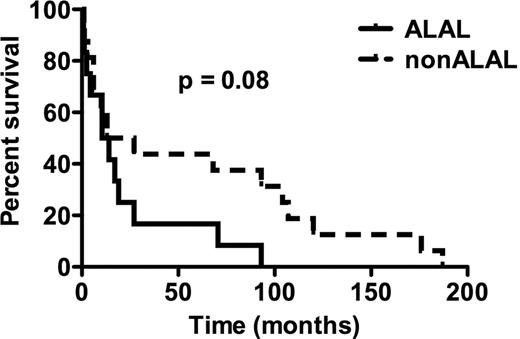Abstract
Abstract 2546
Acute leukemias of ambiguous lineage (ALAL) are defined by the lack of clear evidence of differentiation along a single lineage and include mixed-phenotype acute leukemias (MPAL) and acute undifferentiated leukemia (AUL). These rare acute leukemias (AL) pose diagnostic and therapeutic challenges. Criteria for ALAL/MPAL diagnosis were proposed by the European Group for the Immunological Characterization of Leukemias (EGIL) and incorporated into the 2001 World Health Organization (WHO) classification of myeloid neoplasms. The most recent 2008 WHO classification proposed a much simplified diagnostic approach to MPAL/ALAL that requires clinical validation.
We retrospectively analyzed the pathologic and clinical features of 29 cases of acute leukemia diagnosed and treated at our institution between 1995–2010. All AL patients with any of the following key words identified in the pathology and flow cytometry databases were reviewed: T/myeloid, B/myeloid, undifferentiated, mixed phenotype, anomalous expression, unclassified, biphenotypic, bilineal, biclonal. Pathology, flow cytometry, and cytogenetics reports were reviewed by 2 hematopathologists and reclassified according to EGIL and 2008 WHO criteria. Treatment regimens were reviewed and overall survival assessed for each patient.
In summary, this single institution retrospective review shows that 2008 WHO classification simplifies the diagnosis and limits the number of ALAL/MPAL compared to EGIL score system but this rare entity remains a diagnostic challenge. Over half of these 29 cases preliminarily diagnosed as acute leukemia with dual or uncertain lineage were re-classified as ALL. Although limited by small patient numbers, our preliminary findings suggest that patients diagnosed with ALAL using either EGIL or WHO criteria fare worse than non-ALAL patients and achieve better outcomes (in the absence of allogeneic stem cell transplantation) following ALL-based chemotherapy. Given the overall difficulty in assigning ALAL vs. non-ALAL diagnoses based on EGIL vs. WHO criteria, our results support the upfront treatment of AL of unclear lineage with ALL-based chemotherapy regimens.
No relevant conflicts of interest to declare.
Author notes
Asterisk with author names denotes non-ASH members.



This feature is available to Subscribers Only
Sign In or Create an Account Close Modal